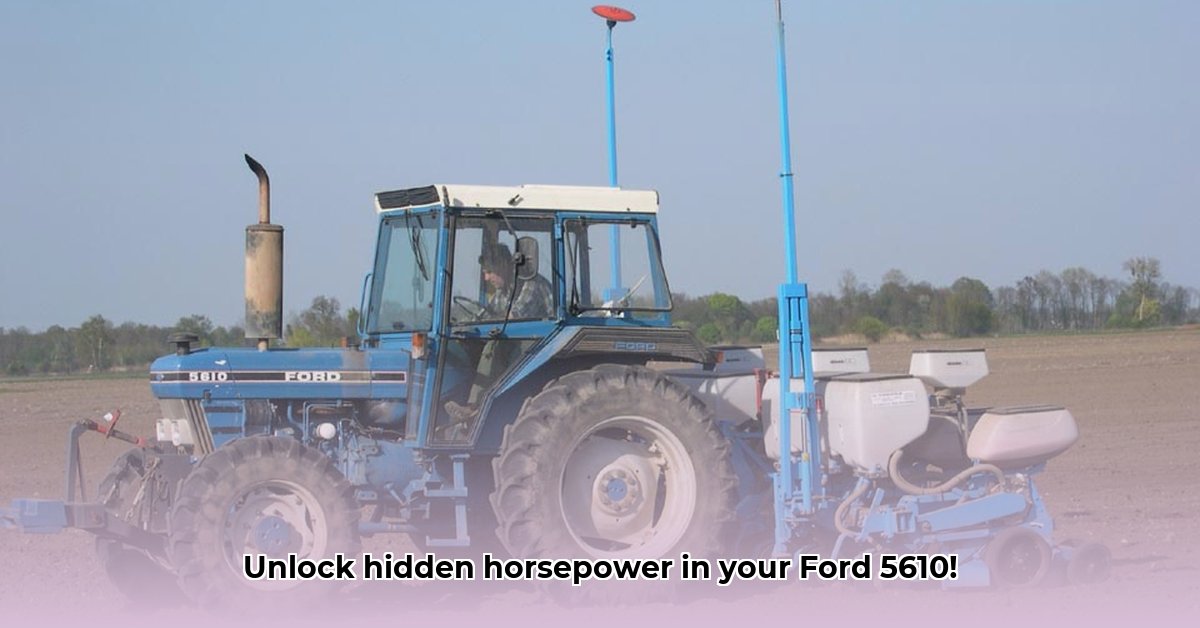
5610 Ford Tractor Horsepower: A Deep Dive
The Ford 5610: A Legacy of Power and Reliability
For generations, the Ford 5610 has been synonymous with dependable farm work. Produced between 1982 and 1993, this tractor earned its reputation as a robust and versatile machine. But understanding its capabilities requires more than just a glance at the horsepower figure – a deeper understanding reveals a machine with both strengths and limitations. For more information on Ford tractors, check out this helpful resource: Ford Tractor Problems.
Decoding Horsepower: Crankshaft vs. PTO
The Ford 5610's horsepower isn't a single number. The engine's crankshaft typically produces between 68.5 and 78.5 horsepower, depending on the model year and specific configuration. However, the more relevant figure for fieldwork is the Power Take-Off (PTO) horsepower—the power transmitted to the implements. This is consistently lower than the crankshaft horsepower. Why the difference? Power is lost through the transmission during its transfer from engine to implement. This is a critical distinction for anyone deciding if this tractor is right for them. Remember, modern tractors often achieve greater efficiency even with slightly lower horsepower ratings due to engineering advancements.
Series I vs. Series II: Subtle Yet Significant Differences
Ford produced two series of the 5610. While both share the same basic engine, the Series II models (generally later in the production run) boast a refined hydraulic system. This results in smoother operation and potentially more efficient power transfer to implements. This smoother power delivery translated to a more productive and less strenuous experience when operating the tractor. Although raw horsepower might not vary drastically, the improved hydraulics significantly impact overall performance. Consult your owner's manual or a reliable parts database for the exact specifications of your 5610.
Beyond Horsepower: Factors Affecting Tractor Performance
While horsepower is crucial, it's not the only factor influencing a tractor's capabilities. The 5610 utilized an open-center hydraulic system, standard for its time but less efficient than the closed-center systems found in modern tractors. This means heavier tasks might take longer. PTO speed is another factor; the 5610 typically offered 540 and 1000 RPM settings. Selecting the proper PTO speed is critical for optimal implement performance and to prevent damage. Choosing the right tractor always requires consideration of its overall capabilities and suitability for your specific needs and tasks. A Ford 5610 might not be suitable for modern large-scale farming, but that doesn't diminish its value in other contexts.
Is a Ford 5610 the Right Tractor for You?
The best tractor is determined completely by individual needs and priorities. Restoration enthusiasts might find the 5610's simple design and rugged construction highly appealing. For smaller farms or hobbyists, its straightforward mechanics can translate into easier maintenance and lower repair costs compared to modern machines. However, farmers requiring high hydraulic flow rates or frequently using large implements are better served by more powerful, contemporary tractors. The 5610 serves its niche and should be considered based on the owner's needs.
Maintaining Peak Performance: Essential Maintenance Tips
Regular maintenance is paramount for prolonging the lifespan and efficiency of any tractor, and the Ford 5610 is no exception. This involves timely oil changes, filter replacements, and careful attention to wear and tear on various components. Finding replacement parts might require more effort than with newer models; planning ahead is therefore essential. A well-maintained 5610 can provide years of reliable service.
The Ford 5610 as a Collector's Item: A Piece of Agricultural History
The Ford 5610 holds a special place in the hearts of collectors. Its sturdy build and relatively uncomplicated mechanical design make it highly sought after. This nostalgic appeal, combined with its durable functionality, adds to its value. However, potential collectors should realistically evaluate the costs and challenges associated with parts sourcing and restoration before committing to ownership.
A Concise Comparison: Series I vs. Series II
| Feature | Series I | Series II |
|---|---|---|
| Approximate Horsepower (hp) | 68.5 - 72 | 72 - 78.5 |
| Hydraulic Pump Flow (gpm) | Approximately 9.7 | Approximately 18.2 |
| Rear Lift Capacity (lbs) | Approximately 3120 | Approximately 4040 |
Note: These figures are approximate. Always consult your owner's manual for precise specifications.
The Enduring Legacy of the Ford 5610
The Ford 5610's significance extends beyond its horsepower rating. It symbolizes a significant era in agricultural machinery, representing robust, reliable design, and a hardworking legacy. While indirect, its influence on contemporary agricultural technology remains evident. Its story is one of enduring quality and practical functionality. It remains a powerful testament to an era of simpler, yet highly effective engineering.